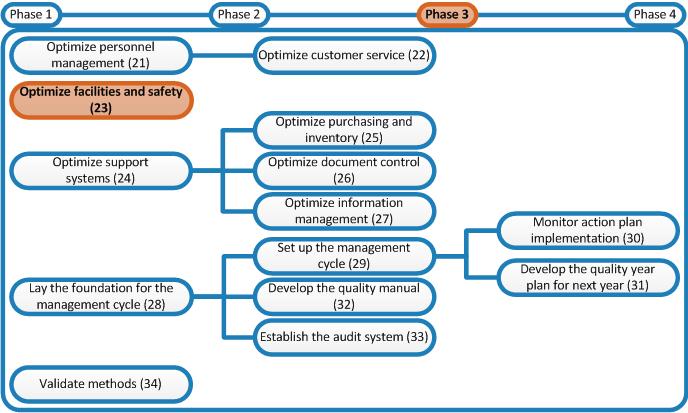
Title
Why
All the items stored in the laboratory need proper protection and need to be stored in an orderly fashion. This prevents loss due to damaging of items (such as reagents, records, etc.) but also improves work and cost efficiency. By having a good system in place that provides an overview of where which item is stored, everything can be found quickly. Moreover, by having a system in place where old reagents are used first (First-in-first-out) the loss of money due to expiry of reagents also decreases. By having good storage facilities less waste of resources will occur, for example due to reagents falling from shelves.
What
Storage spaces need to be upgraded for all types of materials (including primary samples). Think of the following:
- Storage areas must be kept clean and well maintained, and suitable for the materials stored. They should be protected as much as possible from outside detrimental influences such as rain, snow, insects, dust etc. All storage areas should be accessible only to authorized staff to guarantee security and privacy and should thus be lockable.
- Samples must be clearly labeled and stored correctly, separated from reagents and supplies.
- When stocks are made from culture, be sure to store these in appropriate conditions.
- The same applies to reagents and supplies.
- When necessary, store reagents in a properly functioning refrigerator or freezer that is attached to a generator.
Important is to be sure that the freezer and refrigerator are functioning correctly at all times. This can be achieved by monitoring the temperature at regular intervals on log sheets. When a rise in temperature is detected, direct corrective and preventive actions are needed. More information on this was already provided in Phase 2 - Facilities and Safety"Monitor and record environmental parameters and equipment parameters". In the right-hand column a document with background information about sample storage, retention and disposal from the the WHO Laboratory Quality Management System (LQMS) handbook is provided.
- Storage of all types of materials must be arranged in a logical way so that everything is easily retrievable from the storage area. Use a coding system that is logical and user friendly for storing samples and laboratory information (documents and records such as reports, SOPs, etc.). Make registers for the various storage areas in which an up-to-date overview is provided of all the materials present in the storage area, including the details of these materials (see the Hazardous Material Register for examples of these details).
- Storage of reagents and supplies must be stacked or arranged in a safe manner to prevent them from falling of shelves.
- Manufacturers' guidelines for reagent storage must be met.
- Special storage requirements must be met for flammable liquids, compressed gasses, and any other reagents with special requirements. This means that, if necessary, fire-proof and/or ventilated cabinets need to be installed.
- The temperature of storage areas should meet the requirements of the reagents and supplies (as indicated on the containers or labels), be controlled, and monitored.
- Equipment must be stored under appropriate conditions (protected from heat, humidity and direct sunlight). Defective equipment is disinfected and placed outside the laboratory.
- Documents and records must be stored under appropriate conditions (protected from insect infestation, humidity, direct sunlight, etc.). A fire proof cabinet must be used which can be locked with key to protect from unauthorized access.
How & who
Biosafety Officer in combination with the Stock Officer:
- Make a list of storage areas and the requirements to which these storage areas should comply (use the ISO 15190 standard) for each of the following:
- Reagents (examples of types of storage areas needed: stockroom, refrigerators, freezers, -80 freezer)
- Cell stocks
- Defective equipment and spare parts
- Documents and Records
- Primary samples
- Develop, together with the laboratory manager, a plan to create these storage areas.
- Create the storage areas once appropriate funding has been obtained.
- Write an SOP with procedures to follow for storing all different types of materials.
Laboratory manager:
- The Biosafety Officer makes a list of storage areas required including the requirements to which these should comply. After this, develop together with the Biosafety Officer a plan for creating the storage areas.
- Calculate and start looking for the funding needed.
- When funding has been obtained, supervise the execution of the plan for creating storage areas.


